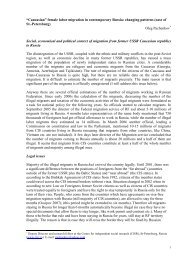THORIUM AS AN ENERGY SOURCE - Opportunities for Norway ...
THORIUM AS AN ENERGY SOURCE - Opportunities for Norway ...
THORIUM AS AN ENERGY SOURCE - Opportunities for Norway ...
You also want an ePaper? Increase the reach of your titles
YUMPU automatically turns print PDFs into web optimized ePapers that Google loves.
11. Radioecology<br />
12. Decommissioning<br />
ADS requires in addition a very comprehensive field:<br />
13. Accelerator technology.<br />
The abbreviations below will be used in the following:<br />
IFE = Institute <strong>for</strong> Energy Technology (Kjeller and Halden)<br />
NTNU = Norwegian university of Science and Technology (Trondheim)<br />
UiB = University of Bergen<br />
UiO = University of Oslo<br />
UMB = Norwegian University of Life Sciences (Ås)<br />
UNIK = University studies at Kjeller<br />
Research, Development, Education and Training<br />
There are currently 4 universities in <strong>Norway</strong> providing full Master and PhD programs within<br />
nuclear sciences:<br />
1. UiO: Master in Nuclear Chemistry, Master in Nuclear Physics, Master in Material Science and<br />
PhD within the same areas.<br />
2. NTNU: Master and PhD in Material Science.<br />
3. UiB: Master and PhD in Nuclear Physics.<br />
4. UMB: Master in Radiochemistry, EU Master in Radioecology and PhD within the same areas.<br />
Additional courses within nuclear sciences are given at universities and other institutions. There<br />
is already a basis <strong>for</strong> activities and competence in <strong>Norway</strong> <strong>for</strong> relevant research, education and<br />
training:<br />
1. Reactor used in operation training (IFE, UNIK).<br />
2. Safety and reliability (man – machine) (IFE Halden).<br />
3. Courses in multi component transport (from the oil industry) (NTNU, UiO).<br />
4. Electrical power generation and turbine technology (NTNU).<br />
5. Energy production and use (IFE, UiB, UiO, UMB).<br />
6. Radiation protection (IFE, NTNU, UiB, UiO, UMB).<br />
11.2 Norwegian Competence in Nuclear Energy Technology<br />
The first reactor in <strong>Norway</strong> was started at Kjeller in 1951, and made <strong>Norway</strong> a pioneering nation<br />
in nuclear technology. This is not so today, despite the high international status of the research<br />
reactor in Halden. Today IFE operates two old research reactors. Both are heavy water<br />
moderated and cooled. The thermal power of the Halden reactor is 20 MW, the Kjeller reactor<br />
thermal power is 2 MW.<br />
The nuclear engineering development at IFA (now IFE) focused especially on nuclear reactors <strong>for</strong><br />
ship propulsion and the development of computer codes <strong>for</strong> calculation of the fuel cycle and power<br />
distribution of power reactors. The computer codes were used in Germany, Switzerland, Sweden,<br />
Spain and USA.<br />
This development and marketing was taken over in the 1970s by a spin off company, Scandpower.<br />
The nuclear part of Scandpower was bought by Studsvik in 1998, and the name was changed to<br />
97

















